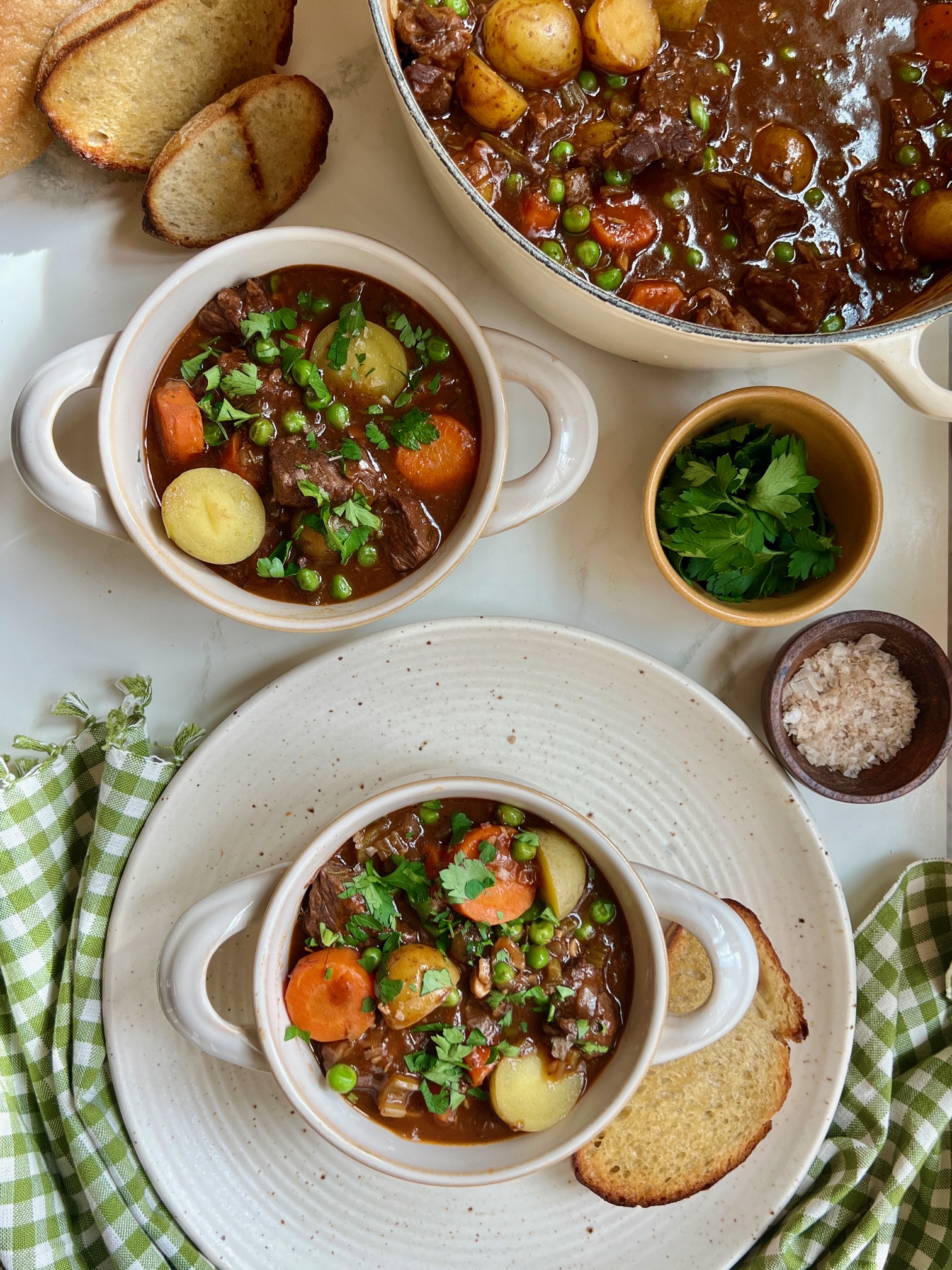
Slow Braised Beef Stew
INGREDIENTS
- 3 pounds boneless beef chuck, cut into 1½-inch pieces
- 3 tablespoons olive oil
- 1 large yellow onion, diced
- 3 celery stalks, diced
- 7 cloves garlic, minced
- 1 teaspoon each: salt, pepper, garlic powder and onion powder
- 1 teaspoon dried thyme
- 1 teaspoon dried rosemary
- 1/2 teaspoon celery seed
- 2 tablespoons tomato paste
- 2 tablespoons balsamic vinegar
- 2 tablespoons cornstarch
- 2 tablespoons Worcestershire sauce
- 1 cups dry red wine
- 4 cups beef broth
- 1 tablespoon Better Than Boullion Roast Beef
- 2 bay leaves
- 4 sprigs fresh thyme (optional)
- 2 sprigs fresh rosemary (optional)
- 4 large carrots, peeled and cut into 1-inch chunks
- 24 ounces baby Yukon potatoes, halved or quartered
- 1 cup frozen peas, thawed to room temperature
- Fresh parsley for garnish
INSTRUCTIONS
Stove & Oven Method
- Preheat the oven to 325°F and set a rack in the lower middle position.
- Pat the beef dry and season with salt and pepper. In a large Dutch oven or heavy soup pot, heat 1 tablespoon of the olive oil over medium-high heat until hot and shimmering. Brown the meat in 3 batches, turning with tongs, for about 5 minutes per batch; add one tablespoon more oil for each batch. (To sear the meat properly, do not crowd the pan and let the meat develop a nice brown crust before turning with tongs.) Transfer the meat to a large plate and set aside.
- Add the onions, celery, garlic, salt, pepper, garlic and onion powders, dried thyme and parsley, and celery seed; cook, stirring with a wooden spoon and scraping the brown bits from bottom of the pan, for about 5 minutes. Add the tomato paste and balsamic vinegar; cook for a minute more. Add the beef with its juices back to the pan and sprinkle with the cornstarch. Stir with wooden spoon until the cornstarch is dissolved, 1 to 2 minutes. Add the wine, beef broth, Worcestershire sauce, bay leaves, and fresh thyme and rosemary if using. Stir with a wooden spoon to loosen any brown bits from the bottom of the pan and bring to a boil. Cover the pot with a lid, transfer to the preheated oven, and braise for 2 hours.
- Remove the pot from the oven and add the carrots and potatoes. Cover and place back in oven for about an hour more, or until the vegetables are cooked, the broth is thickened, and the meat is tender. Discard the bay leaves and stems, then taste and adjust seasoning, if necessary. Add peas and stir until until warmed through. Garnish with fresh parsley, if desired.
- Note: If you don’t have a Dutch oven or covered pot that is appropriate for the oven, the stew can be cooked on the stove. The timing will be the same and it should be cooked over the lowest setting.
Slow Cooker Method
-
Cook beef, onions, and celery according to the instructions above. Transfer to a large 6 or 8-quart slow cooker.
-
Add the remaining ingredients except for cornstarch peas. Cover and cook on low for 7-8 hours or on high for 4-5 hours. I prefer to cook this slow and low so that the beef becomes tender and the flavors have time to meld together.
